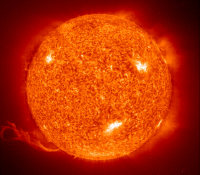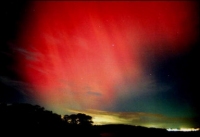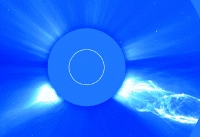Remote Sensing and GIS Use in Coral Reef Management
Mochamad Putrawidjaja
Remote Sensing (RS) and Geographic Information System (GIS) have been using in assessing coral reefs for decades by research and academic institutions as well as in managing the resources by the governments. Designed earlier as land-based mapping application, remote sensing and GIS have been applied in coral reef mapping twenty years ago, addressing the requirement of remotely sensed monitoring of extremely wide coral reef area. However, many constraints occurred in its development in marine sector. In this paper, I will describe technical, institutional, data availability and other constraints in developing remote sensing and GIS in marine field, particularly in Indonesia, the country that has the widest coral reef region and the most diverse in marine biodiversity.
Initially, technical constraint in applying remote sensing and GIS in the sea is its capacity to scan the seafloor through certain depth where coral reef lives. Seawater properties, such as salinity and temperature, is potentially scattered or dispersed the electromagnetic wave transmitted by the satellite (Winarso and Budhiman, 2000). Besides, it is difficult to interpret and distinguish a wide array of underwater features from satellite images. Reef flat may be seen identical in several places but appear with distinguished spectrum in satellite image because of different depth and opacities.
Eventually, many researches have been conducted to address that constraint. For instance, CASI (compact airborne spectrographic imager) method that can reach 15 meters depth (Mumby 1998 and Minghelli-Roman et. al. 2000). Moreover, other application of Landsat 7-ETM+, SPOT HRV, SeaWiFS LAC, space shuttle photography and HDTV were able to determine the reef slope and up to 7 classes simple habitat characteristic (Andréfouët et. al. 2000). In contrast, reef biologists have not yet agreed in defining the term “reef” as well as standardizing the classification scheme of the variety reef habitat type.
Vast needs in monitoring the reef health motivate the development of the system that can identify and determine the type seafloor substrate. Australia initiated the effort since they started to protect the Great Barrier Reef from natural and anthropogenic threats. CSIRO (Commonwealth Scientific, Industrial and Research Organization) and AIMS (Australian Institute of Marine Science) intensively observed the health of the Great Barrier Reef using many techniques, such as spectral measurement of radiometric reflectance (Skirving et. al. 2000). Coral bleaching events in the Indo-Pacific region, both as a result of El Ninõ events (1982-83 and 1997-98) and crown-of-thorn starfish grazing accelerates the development. Later, the United States developed higher technology into the system. NASA and USGS developed a cost-effective instrument for investigating high diversity and species rich reefs, the Experimental Advanced Airborne Research LIDAR/EAARL (Brock et. al. 2000). Furthermore, USGS also applied digitized aerial photographs and airborne digital SHOALS (Scanning Hydrographic Operational Airborne LIDAR Survey) laser bathymetry data to locate features on the reef, define the local geomorphology, and as a geographic base to plot results.
Although studying coral reefs was more likely discussing its spatial intactness and competition among its inhabitant, remote sensing and GIS were mostly used to estimate area coverage. Many researches focused more on how to get the finest resolution to map coral reefs, instead of how to define the reef itself. In addition, since most of remote sensing and GIS applications were previously designed to map land-based features, such as Landsat TM satellite images, they can clearly define the building beneath 2-m tree canopy but they could not determine the seabed substrate type below 20 m depth. In fact, observing coral reefs below sea level was not as easy as observing land-based features.
Another technical constraint is how to distinguish the type of seafloor substrate. CASI (compact airborne spectrographic imager), which can reach below 15 meters depth, was unable to determine whether the shelf features shown on the image was coral, sand or any other substrate. Minghelli-Roman et. al. (2000) suggested to combine CASI with ground-level spectra and photographic records to obtain spectral reflectance images of a species rich coral reef. Other data produce by Landsat 7-ETM+, SPOT HRV, SeaWiFS LAC, space shuttle photography and HDTV, which can determine the reef slope and simple habitat characteristic, were unable to determine the coral species (Andréfouët et. al. 2000).
Remote sensing and GIS were more applied as mapping tool instead of management tool in developing countries, particularly in this paper is Indonesia. Intensive use of remote sensing and GIS in Indonesia initiated in the World Bank-funded Land Resource Evaluation and Planning project (LREP) conducted by the Indonesia’s National Land Agency (BPN) in early 1980s. Later on, BPN and the Indonesian Institute of Science (LIPI) attempted to apply such system to marine sector through the Marine Resource Evaluation and Planning project (MREP), which seems to be persisted since they were using the similar software of previous LREP project. In the last ten years, LIPI is conducting the World Bank-loaned Coral Reef Mapping and Management Project (Coremap). In the last five years, more government bodies are also mapping Indonesian coral reefs, including the Indonesia’s National Aeronautics and Space Agency (LAPAN), National Coordination Body of Survey and Mapping (Bakosurtanal) and National Agency of Assessment and Application of Technology (BPPT). Apparently, those organizations performed more coral reefs mapping, instead of gathering related information to be inserted into the system. Most of them focused on introducing and assessing various technologies to map the reefs, instead of developing certain appropriate technique to manage the data.
On the other hand, human resource that can operate the system was not developed very well because lack of expertise and specialties. Many experts and specialists preferred to work in private sector, rather than teaching or doing the researches.
Data availability is another major constraint in developing remote sensing and GIS in coral reef management. Most of basic marine maps in Indonesia were developing upon the more-than-fifty-year-old Dutch’s navigation maps. Most of those maps did not update for years and also did not cover most of remote regions, where coral reefs are still relatively undisturbed and abundant. On the other hand, the satellite image price is very expensive.
Consequently, many coral reef management projects in developing countries attempt to combine the remote sensing and GIS with participatory community mapping. Such combination makes the coral reef mapping is easier to perform and the result can accommodate all stakeholders’ interest, like how the URI’s Coastal Resource Management Project (CRMP) performs in several locations in Indonesia.
That vast development of various techniques and methods to assess coral reefs, both on its coverage and its species richness, seems promising to address the requirements of cost-effective tools to manage the reefs. However, it does not comparable with the deployment cost. Since most of coral reefs are mostly located in economically weak developing and underdeveloped countries, cost of deploying such high technology, which is mostly cost in U.S. dollar, is still a big problem to be solved.
The above conditions made the remote sensing and GIS deployment was slower than its development, and put them either in experimental or conceptual format. Finally, many coral reef management projects in developing countries still preferred to put the community-based mapping as a basis of coral reefs management and put GIS only as presentation enhancement device.
Annotate Bibliography:
Andréfouët, S., J.A. Robinson, G.C. Feldman, F.E. Muller-Karger, C.M. Hu, B. Salvat. 2000. Comparison of space sensors for estimation of coral reef areas in South Pacific atolls. Dept. of Marine Science, University of South Florida. Saint Petersburg, Florida. Proc. 9th International Coral Reef Symp.: 233.
The authors describe variety of remote sensing data, including Landsat 7-ETM+, SPOT-HRV, SeaWiFS Local Area Coverage (LAC), Space Shuttle photography and High Definition Television (HDTV), collected over various atolls of the Tuamotu archipelago (French Polynesia). They found that SeaWIFS data were useful to estimate the atoll area, but cannot distinct between rim and lagoon because lack of sufficient spatial resolution to provide better than 80% accuracy. Space Shuttle HDTV images and photographs were useful for simple characterization of the rims (4 classes) and lagoon features, but could not accurately classify at more detailed levels. SPOT-HRV or LANDSAT/ETM+ were useful to classify the rim structure and simple habitat zones, but did not provide information on the steep outer or inner slopes.
Baxter, K. 2000. Assessing the extent of coral bleaching using aerial photography and image processing techniques, Great Barrier Reef, Australia. School Of Tropical Environment Studies and Geography, James Cook University, Townsville, Australia.
The author found that the management authorities difficult to monitor large-scale disturbances, primarily due to the extent and isolation of their jurisdictions. Remote sensing provides a potential means of cost effectively monitoring coral reefs across a variety of scales. In this paper, he applied remote sensing techniques to high-resolution aerial photographs of two Great Barrier Reef sites to detect coral reef bottom types and in particular, coral reef bleaching. He also applied a supervised remote sensing technique and unsupervised techniques to provide an efficient and accurate means of distinguishing more than 50% bleached corals at couple scales of observation. However, the result accuracy still required to be improved. Determining at which scale reef types are best classified may improve accuracy and ensure the overall health of the reef system is not misinterpreted.
Brock, J.C. and C.W. Wright. 2000. Preliminary results from a NASA Experimental Advanced Airborne Research LIDAR (EAARL) survey of Pacific Reef in Biscayne National Park, Florida. USGS Center For Coastal Geology, Florida. Proc. 9th International Coral Reef Symp.: 233
This paper describe the success of NASA and USGS to develop low-cost instrument to investigate high density and species rich coral reef, the Experimental Advanced Airborne Research LIDAR (EAARL), which couples a small field-of-view receiver with a high repetition rate (5000 Hz), low power, short-pulse laser. This airborne LIDAR remote sensing technique can acquire highly detailed bathymetry and bottom texture, and water depth for the correction of passive imagery, as well as stimulate and detect the fluorescence of coral heads; algae and other benthic cover types. This method was specifically designed for low cost coral reef investigation that require extremely high density bathymetry and hyperspectral scanning for useful benthic reef classification.
Bryant, D., L. Burke, J. McManus and M. Spalding. 1998. Reef at Risk: A Map-Based Indicator of Threat to the World’s Coral Reefs. Box: Tools and Techniques for Monitoring and Mapping Coral Reefs. World Resource Institute, International Center for Living Aquatic Resource Management, World Conservation Monitoring Centre and United Nations Environment Program. p: 40.
This book describes the use of geographic information on coral reefs around the world as a tool to indicate the threat. In one of the report’s boxes, the authors discuss that it is not necessary to deploy high technology or satellite-based method to monitor and map. A low-tech but user friendly community-based reef mapping is one of the most popular and widely consumed in managing coral reefs resources, particularly in less accessible and low infrastructure available region in developing countries. Although they provided an overview on the advantage and disadvantage of some techniques in obtaining coral reef map, the authors did not recommend any specific method.
Chavez P.S., Jr. and M. Field. 2000. Use of digitized aerial photographs and airborne laser bathymetry to map and monitor coral reefs. The United States Geological Survey. Proc. 9th International Coral Reef Symp.: 234.
This paper report that U. S. Geological Survey is using digitized aerial photographs and airborne digital SHOALS (Scanning Hydrographic Operational Airborne LIDAR Survey) laser bathymetry data to help map and study coral reef environments. Main advantage of this remotely sensed data is it is capable to locate features on the reef, define the local geomorphology, and as a geographic base to plot results. A promising application deals with temporal monitoring of change.
Ledrew, E.F.; M. Wulder and H. Holden. Change detection of satellite imagery for mapping and monitoring stressed corals. Department of Geography, University of Waterloo, Ontario, Canada. Proc. 9th International Coral Reefs Symp.: 236
This paper determines a procedure for change detection from the multidate SPOT data that is independent of spatial variations in water depth over the features of interest. The Getis statistic, which is based solely on image characteristics, is evaluated as a tool for change detection. Preliminary examination suggests that it meet the requirements for rapid assessment for environmental change without the need for individual image calibration based upon in situ information.
Minghelli-Roman, A., J.R. M. Chisholm, M. Marchioretti, H. Ripley & J.M. Jaubert. 2000. How good is CASI for Red Sea coral reef survey? Observatoire Océanologique Européen, Centre Scientifique de Monaco, Monaco. Proc. 9th International Coral Reef Symp.: 237
This paper describes the deployment of CASI (compact airborne spectrographic imager) system combined with ground-level spectra and photographic records to obtained spectral reflectance images of a species rich coral reef near Gübal Island, Red Sea. Comparison of CASI-derived thematic maps (by decomposing the pixel reflectance signatures) with photographed reef areas indicated that CASI has the potential to discern and map diverse reef communities to a depth of at least 15 m with good precision.
Mumby, P.J., E.P. Green, A.J. Edwards and C.D. Clark. 1997. Coral reef habitat mapping: how much detail can remote sensing provide? Marine Biology 130: 193-202
The authors studied the accuracy obtained by different imaging techniques and discusses its effectiveness and efficiency based upon cost per image. They found that Landsat TM was the most accurate and cost effective sensor to produce satellite imagery, but it was also less accurate, only 37 %. A 1:10,000 aerial photograph could provide the same detail as the satellite. On the other hand, CASI (compact airborne spectrographic imager) was the most consistently accurate sensor, about 89% in its accuracy. This article should consider to be reviewed by limited budgets institutions which willing to study coral reefs.
Mumby, P.J. E.P. Green, C.D. Clark and A.J. Edwards. 1998. Digital Analysis of multispectral airborne imagery of coral reefs. Coral Reefs 17: 69-69
In this article, authors discuss in detail the use of CASI (compact airborne spectrographic imager) to view 1-m pixels in 8 spectral bands. Reef images taken with CASI was compared to other satellite images produced by Landsat MSS, Landsat TM, SPOT XS, SPOT Pan and merged Landsat TM/SPOT Pan over Turks and Caicos Islands (British West Indies). Overall accuracy of CASI-derived habitat maps were 89% and 81% for coarse and fine levels of habitat discrimination, respectively. Accuracy was greatest once CASI data had been processed to compensate for variations in depth and edited to take account of generic patterns of reef distribution. These overall accuracy were significantly (P<0.001) better than those obtained from satellite imagery of the same site. In addition, this article was more likely a detail technical description of previous article.
Spalding, M.D. 1997. Mapping global reef distribution. Proc. 8th Coral Reef Symposium 2: 1555-1560.
World Conservation Monitoring Centre (WCMC) prepared a new estimation of global coral reef distribution by mapping emergent reef crest and very shallow reef systems. Data had been raster, using 1-km grid squares, as a means of reducing errors arising from variation in scale. Then, global and regional reef coverage was calculated from the resultant grid. They found difficult to create map since data was available in great different quality and scales, ranging from 1:250,000 to 1:1,000,000. However, the resulting map seems not much improved from previous maps.
Skirving, W., T. Kutser, J. Parslow, T. Done, M. Wakeford, I. Miller and L. Clementson. Remote sensing of coral reef health. Australian Institute of Marine Science, Townsville, Australia. Proc. 9th International Coral Reefs Symp.: 240
A joint project of CSIRO and AIMS tried to answer the question of the usefulness of remote sensing for mapping and monitoring the health of coral reefs. Unlike most previous projects, this project has taken a fresh approach to this problem. Instead of using any air- or space-borne data, the project used spectral measurements of radiometric reflectance to allow the development of models, which will help answer the main question of “how useful is remote sensing”, as well as help determine the form of the most suitable instrument. This paper described the techniques used to collect spectral information from the water column and benthic habitat in and around three Great Barrier Reef’s coral reefs. The reefs were chosen to represent a range of water quality. Along with the description of the instrumentation and techniques, some preliminary results were presented.
Winarso, G. and S. Budhiman. 2000. Application of remote sensing data for coral reef mapping in Indonesia. Indonesian Institute of Aeronautics and Space (LAPAN). Bogor, Indonesia
This paper examines the research result of the remote sensing application for coral reef mapping, the problems that occurred, the suggested method to solve the problem, the ability of remote sensing and the quality of the result. Landsat-TM data mainly used as primary data and SPOT multispectral data as comparison because of the availability of data in Indonesia. The author also describes their observation on Indonesia’s experience in implementing remote sensing data to assess coral reef, because it is the easiest and the cheapest. The problem occurred when the electromagnetic wave utilized to identify the coral either scattered or dispersed by the water mass, that made the techniques did not work well.
Recommended websites:
http://www.uncwil.edu/isrs International Society of Reef Studies
http://www.iclarm.org International Center for Living Aquatic Resource Management
http://www.reefcheck.org Reef Check International
http://www.wri.org World Resource Institute who published Reef at risk: a map-based indicator of threats to world coral reefs
http://www.wcmc.org World Conservation Monitoring Centre
http://www.ima-indo.org International Marinelife Alliance – Indonesia
http://www.wwf.or.id Worldwide Fund for Nature – Indonesia
http://www.tnc.or.id The Nature Conservancy - Indonesia
http://www.ci-ip.org Conservation International - Indonesia
http://www.crc.uri.edu URI Coastal Research Center
http://www.aims.edu.au, Australian Institute of Marine Science
http://www.csiro.com.au, Australian Commonwealth Scientific and Industrial Research Organization
http://www.gbrmpa.gov.au, Great Barrier Reef Management Authority
http://www.noaa.gov U.S. National Ocean and Atmosphere Administration
http://www.usgs.gov U.S. Geological Service
http://www.lipi.go.id, Indonesian Institute of Science
http://www.coremap.go.id, Indonesian Coastal Resource Management Project
http://www.bakosurtanal.go.id, Indonesian National Coordination Body of Survey and Mapping
http://www.nature.nl/~edcolijn/ Digital Map of Indonesia by Peter Loud


















